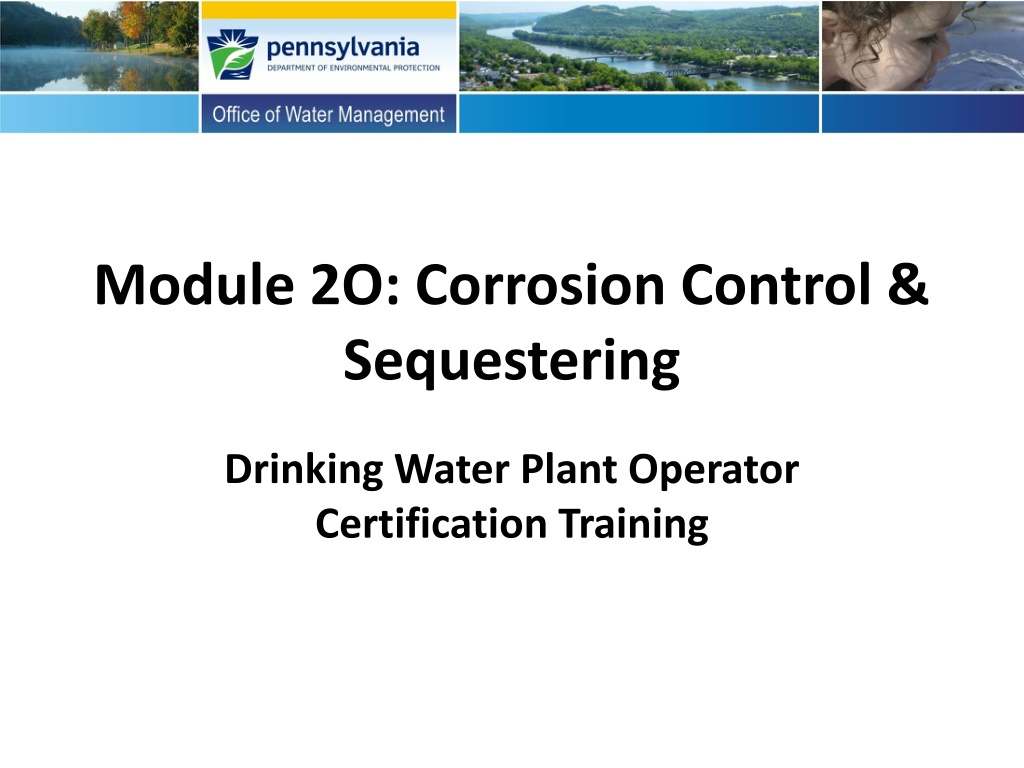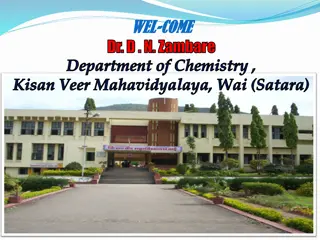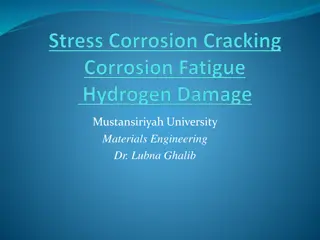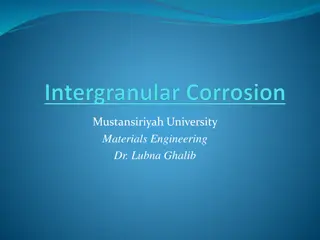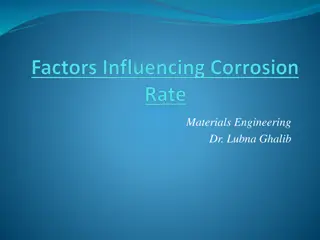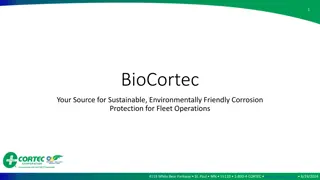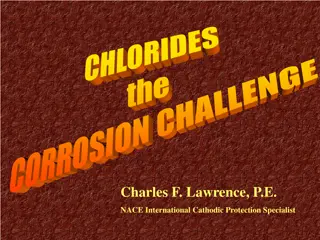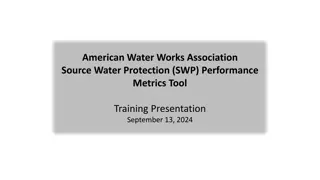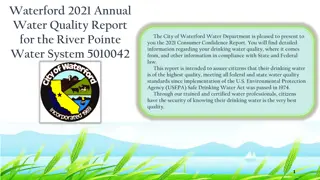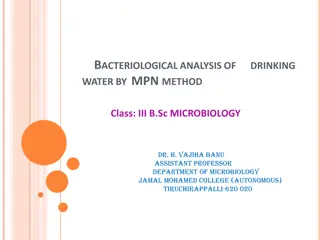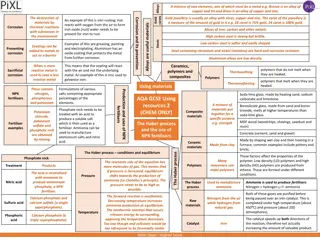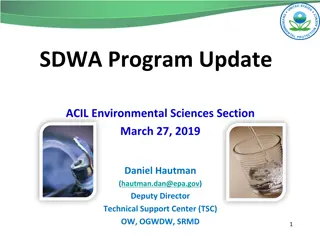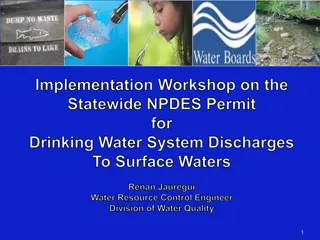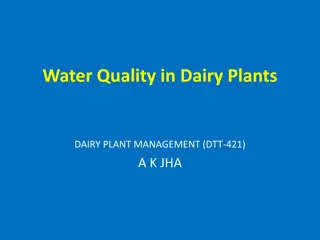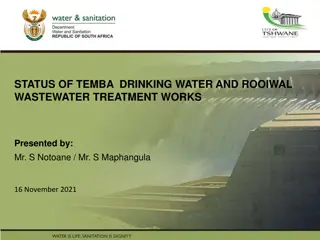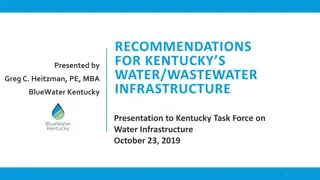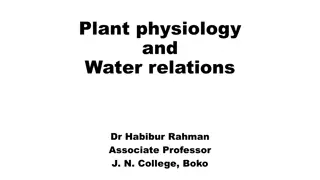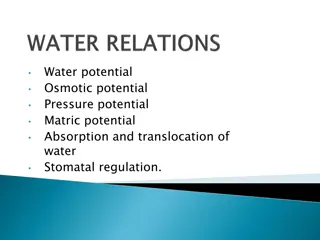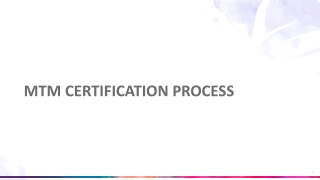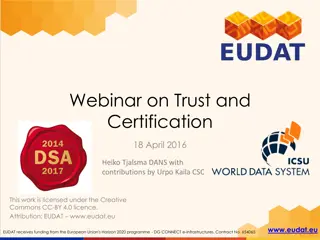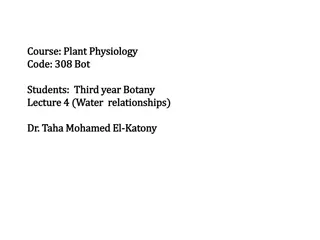Corrosion Control & Sequestering Drinking Water Plant Operator Certification Training
This module covers topics such as the Lead and Copper Rule (LCR), corrosion tuberculation examples, quick reference guides for LCR compliance, and exercises related to population sizes and water sample analysis. The content emphasizes understanding LCR provisions, sampling protocols, analytical methods, and treatment techniques for managing lead and copper levels in drinking water plants.
Download Presentation

Please find below an Image/Link to download the presentation.
The content on the website is provided AS IS for your information and personal use only. It may not be sold, licensed, or shared on other websites without obtaining consent from the author. Download presentation by click this link. If you encounter any issues during the download, it is possible that the publisher has removed the file from their server.
E N D
Presentation Transcript
Module 2O: Corrosion Control & Sequestering Drinking Water Plant Operator Certification Training
Unit 1 Lead and Copper Rule (LCR) After this unit, you ll be able to: Describe the major provisions of the LCR Describe the sampling protocols for lead and copper tap samples and water quality parameter samples Identify selected EPA-approved analytical methods 2
Examples of Corrosion Tuberculation 3
LCR: Quick Reference Guide Workbook Pages RG-1 through RG-3: Consumer Tap Notice new requirement Major monitoring provisions Table 1: Lead & copper tap and water quality parameter (WQP) distribution monitoring Table 2: Criteria for Reduced lead and copper monitoring 5
LCR: Quick Reference Guide Workbook Pages RG-4 through RG-6: Treatment Technique and Sampling Requirements if the action level is exceeded Water Quality Parameters Corrosion Control Treatment Treatment Technique Requirement if the LEAD action level is exceeded Lead Public Education Lead Service Line Replacement 6
LCR: Quick Reference Guide Workbook Page RG-7: Additional LCR Resources links: LCR Web page Subchapter K of Chapter 109 EPA LCR documents 7
Key Points Turn to page 1-11 to summarize the unit key points. 8
Unit 1 Exercise 1. Under the LCR, insert the population sizes for the following types of systems: System Size Population Served Small 3,300 and fewer Medium 3,301 to 50,000 Large 50,001 and greater 9
Unit 1 Exercise 2. percentile value of the following samples? 0.018 mg/L Is this system exceeding the action level? YES Based on the following lead tap sample results, what is the 90th Sample site 1 2 3 4 5 6 7 8 9 10 Lead Level (mg/L) 0.020 0.018 0.016 0.014 0.011 0.010 0.009 0.008 0.007 0.006 10
Unit 1 Exercise 3. an AL, name the first step in the corrosion control treatment activity milestones? Submit a CCT feasibility study within 18 months. When a small or medium system exceeds 11
Unit 1 Exercise 4. considered water quality parameters? Circle all that apply. a.Temperature Which of the following parameters are b.Conductivity c.pH d.alkalinity e.odor 12
Unit 1 Exercise 5. small or medium systems) must collect WQP samples during monitoring periods in which either AL is exceeded. a. True___X___ Systems serving 50,000 or less people (i.e. b. False______ 13
Unit 1 Exercise 6. copper tap sample is: a. 500 ml The sample volume size for a lead and b. 1 liter 7. An operator must measure pH within 15 minutes of sample collection. 14
Unit 1 Exercise 8. What methodology is NOT an EPA-approved method? a. Titrimetric b. Electrometric c. Colorimetric d. Color Wheel 15
Unit 2 Corrosion Principles and Theory After this unit, you ll be able to: Explain chemistry principles that relate to corrosion Identify factors which affect corrosion Identify the LCR corrosion control treatment alternatives Describe important factors affecting each type of treatment 16
Acids Workbook Page 2-3 Produce H+ ions Recognized by the H in the chemical formula H+ + Cl- HCl (Hydrochloric acid) 17
Bases Workbook Page 2-4 Produces OH- ions Recognized by the OH at the end of the chemical formula Na+ + OH- NaOH (Sodium hydroxide) 18
Salts Workbook Page 2-4 No ions are produced (acid and base are neutralized) Product of combining an acid with a base NaCl+ H2O HCl + NaOH (Hydrochloric Acid + Sodium hydroxide) 19
The Carbonate System Workbook Page 2-7 THE CARBONATE SYSTEM 100% CARBONATE & HYDROXIDE 50% CARBONIC ACID BICARBONATE 0% pH 4.5 6.3 8.3 10.3 11.3 20
Corrosion Cell Workbook Page 2-9 CORROSION CELL WATER Pb+2 2e- metal surface Cathode Anode 2e- LEAD PIPE OR SOLDER Anode reaction: Pb - 2e- Pb+2 21
Eliminating the Corrosion Cell Workbook Page 2-11 CORROSION CELL WATER metal surface Anode Cathode LEAD PIPE OR SOLDER 22
LCR CCT Alternatives Workbook Page 2-11 pH/alkalinity adjustment Calcium hardness adjustment (CaCO3 precipitation) Corrosion inhibitors 23
Langelier Saturation Index (LSI) Workbook Page 2-17 LSI Values Effect on Water LSI greater than 0 Water is supersaturated and tends to precipitatea scale layer of CaCO3 Water is saturated (in equilibrium) with CaCO3 so a scale layer of CaCO3 is neither precipitated nor dissolved. Water is under saturated, tends to dissolve solid CaCO3 LSI = 0 LSI less than 0 24
pH/alkalinity adjustment & Inhibitors Workbook Page 2-19 Treatment Approach Key Water Quality Parameters Appropriate Chemical Feed Systems pH/alkalinity adjustment Caustic Soda Lime Soda Ash Sodium Bicarbonate pH, alkalinity, temperature Corrosion Inhibitors pH, alkalinity, temperature, metals, hardness, inhibitor residual Orthophosphate Polyphosphate Ortho-poly blends Silicates 25
Key Points Turn to page 2-20 to summarize the unit key points. 26
Unit 2 Exercise When placed in water, acids/bases 1. produce hydrogen ions; acids/bases produce hydroxide ions. A saltis the product of combining an acid 2. and a base. 27
Unit 2 Exercise 3. A finished water pH value of 5.0 indicates: a.Water is basic b.Water is acidic c.Water may corrode pipes and fittings d.Both a and c e.Both b and c 28
Unit 2 Exercise 4. control treatment? a. Minimize amount of lead and/or copper dissolving into tap water. b. Maximize the service life of plumbing materials. c. Improve the hydraulic characteristics of water distribution systems. d. All of the above. What objectives can be met with corrosion 29
Unit 2 Exercise 5. Controlling lead/copper is achieved by forming a protective layer on the pipe wall that eliminates the corrosion cell. a) True b) False 6. What does a Langelier Saturation Index of 1.1 indicate? a.Scaling potential b.Dissolving potential 30
Unit 2 Exercise 7. If an operator adjusts the pH of the finished water above the saturation point for calcium carbonate, this will create a protective coating on the pipe wall. a) True b) False 31
Unit 2 Exercise 8.Determine how the addition of the following chemicals to water will affect pH and complete the table. If I add: The pH will be ___________ (raised/lowered) raised lowered raised lowered raised raised lowered potassium hydroxide nitric acid lime sulfuric acid caustic soda soda ash hydrochloric acid KOH HNO3 Ca(OH)2 H2SO4 NaOH Na2CO3 HCl 32
Unit 3 Corrosion Control Chemicals After this unit, you ll be able to: Identify the common pH/alkalinity adjustment chemicals including: common chemical names, characteristics, operational considerations, impacts and constraints Identify the common corrosion inhibitors and their impacts and constraints 33
pH/Alkalinity Adjustment Chemicals Chemical Formula Common Name Chemical Name Caustic Soda Sodium Hydroxide NaOH Lime Calcium Hydroxide Ca(OH)2 Baking Soda Sodium Bicarbonate NaHCO3 Soda Ash Sodium Carbonate Na2CO3 34
Table 3.2 Chemical Characteristics Use Notes Chemical Name Raise pH. Convert excess CO2 to alkalinity species pH control is difficult when applied to low alkalinity water (<20 mg/L) Caustic Soda Raise pH. Increases alkalinity and calcium content Increases alkalinity with little increase in pH Slurry feed can cause excess turbidity O & M intensive Lime Good alkalinity adjustment choice, but very expensive Sodium Bicarbonate Increases alkalinity with moderate increase in pH More pH increase caused as compared to sodium bicarbonate, but less costly Soda Ash 35
Table 3.3 Operational Considerations Available Forms Safety Considerations Storage Chemical 50% or 25% solution 50% solution requires heated storage room to prevent freezing dangerous to handle, use protective clothing, rubber gloves, rubber apron, face shield, goggles control mists with good ventilation Caustic Soda powder in 50 or 100 lb bags; bulk Dry storage with slurry feed positive ventilation, protective clothing, gloves, face shield, neck cloth, respirator Lime powder; 25 lb drums, 100 lb bags Dry storage with solution feed positive ventilation, protective clothing, gloves, goggles, respirator Sodium Bicarbonate powder in 50 and 100 lb bags; bulk Dry storage with solution feed positive ventilation, protective clothing, gloves, goggles, respirator Soda Ash 36
Personnel Safety Protection Workbook Page 3-6, 3-7 Protective clothing Showers/eye wash equipment First Aid Fendall Personal Emergency Eyewash Station 37
Key Points Turn to page 3-18 to summarize the unit key points. 38
Unit 3 Exercise 1. List the common names for the following pH/alkalinity adjustment chemicals: Chemical Name Common Name Calcium hydroxide Sodium carbonate Sodium hydroxide Lime Soda Ash Caustic soda 39
Unit 3 Exercise 2. When using caustic soda, it is necessary to have at least 20 mg/L of alkalinity to maintain a stable pH. a) True b) False 3. It is not necessary to minimize the length of line for a lime feeder. a) True b) False 40
Unit 3 Exercise 4. Which type of inhibitor is used to control lead? a)Polyphosphate b)Silicates c)Orthophosphate 5. When the pH is raised before disinfection, the inactivation effectiveness of free chlorine is increased. a) True b) False 41
Unit 3 Exercise 6. iron and manganese, why should the chemical feed point should be located before the disinfection process? When using polyphosphates to sequester To avoid oxidizing the iron and manganese with the chlorine which would create iron and manganese precipitates to be pumped out into the distribution system. 42
Unit 4 Chemical Feed After this unit, you ll be able to: Identify components of liquid and dry feed systems Describe liquid and dry feed operation and maintenance activities Perform calculations for the following types of situations: Mixing a % solution Determining Weight of % solution using specific gravity Dry and liquid feed calculations Calculating the Active Ingredient Weight of a % solution 43
Unit 4 Chemical Feed Objectives After this unit, you ll be able to: Describe the steps in developing a pump calibration curve 44
Components of a Liquid Chemical Feed System 3. Calibration Cylinder 7. Metering Pump Shut Off Valves 1. Chemical Storage Foot Valve Suction Strainer 2. Suction Assembly Figure 4.1 45
Components of a Liquid Chemical Feed System Flow 6. Injector Assembly 5. Pulsation Damper 4. Four Function Valve *Anti - Siphon *Backpressure Relief *Pressure Relief *Priming Function 7. Metering Pump 46
Weight of Gallon of Solution Example: 50% caustic soda (NaOH) has a specific gravity of 1.53 Wt of Substance = (Specific gravity of solution x 8.34) Wt of NaOH, lbs/gal = 1.53 X 8.34 Wt of NaOH = 12.76 lbs Each gallon of NaOH weighs 12.76 lbs 47
Davidson Pie 48
Davidson Pie Feed Rate lbs Day Flow 8.34 MGD Dosage mg L 49
Active Ingredient Weight Within this 25% NaOH solution, the active ingredients are yellow. Calculate the yellow weight by: 1. Solving weight equation for a gallon of solution using specific gravity Wt, lbs/gal = (Specific gravity x 8.34) 1.28 X 8.34 = 10.67 lbs/gal 2. Determining active ingredient wt based on % purity a) Convert % purity of solution into a decimal 25% = 0.25 b) Multiply weight of a gallon of solution by % purity 10.67 lbs/gal (Step 1 weight) X 0.25 (% purity) = 2.66 lbs/gal of yellow active ingredients Within the 10.67 lbs of 25% solution, there are 2.66 lbs of active ingredients . 50
